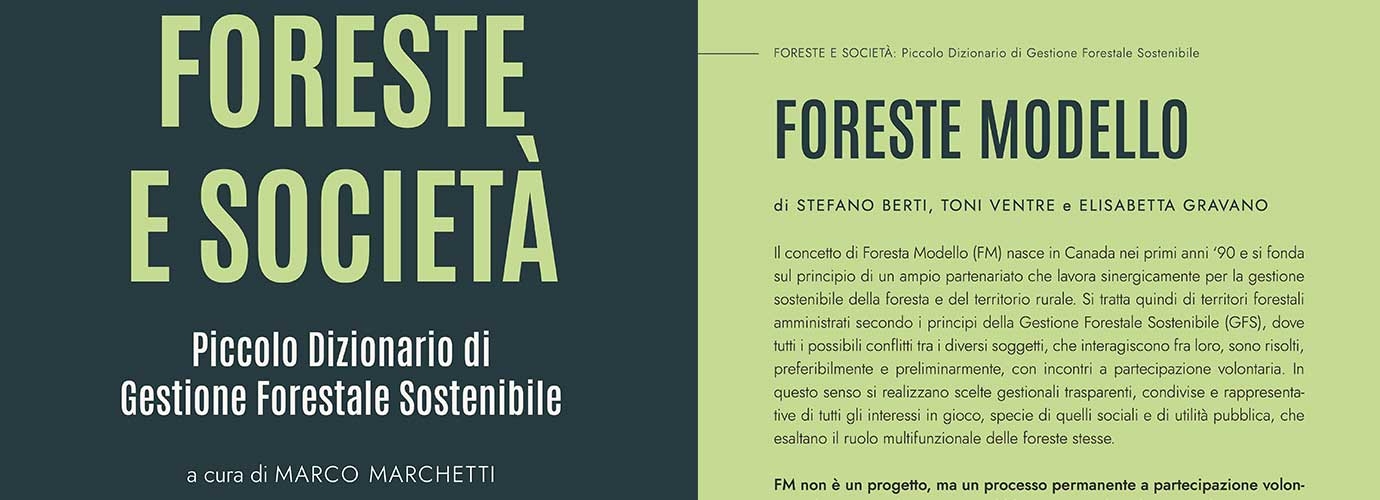What does Model Forest mean? An answer inside the Italian small dictionary “Forests and Society”

Compagnia delle Foreste, the Italian company that managed the communication of our Network, recently released a book that includes also a contribution from the Model Forests Network.
“Forest and Society - Small Dictionary of Sustainable Forest Management” curated by Marco Marchetti and published by Compagnia delle Foreste, is a dense guide within the world of forest and landscape management intended both for those that work already in the sector and who want to approach the topic. Involving more than 80 authors among Italian forestry experts, the book includes a wide range of words and for each of them a contribution that goes beyond the literal meaning alone, giving context and deepness to the analysis.
Among the words there is also “Model Forest” written by Toni Ventre, Elisabetta Gravano (General Secretary and Vice-Secretary of the MMFN) and Stefano Berti (President of the Montagne Fiorentine Model Forest).
Here below the translation of they describe the Model Forests in the Dictionary.
The concept of Model Forest (MF) originated in Canada in the early 1990s and is based on the principle of a broad partnership working synergistically for the sustainable management of forests and rural areas. These are forested territories managed according to Sustainable Forest Management (SFM) principles, where conflicts between stakeholders are resolved, preferably through voluntary participatory meetings. This approach ensures transparent, shared decisions that represent all interests, particularly social and public ones, emphasizing the multifunctional role of forests.
MFs are not projects but ongoing processes involving public and private stakeholders who make joint decisions for a defined forest area, sharing experiences and addressing diverse needs. This permanent process aims to meet human needs sustainably, overcoming challenges and seizing opportunities. It promotes role clarity, subsidiarity, and best practices. In 1992, after the Rio Conference, the Canadian government established the first 10 MFs in Canada with a "visionary" approach: governance starting from sustainable landscape management through territorial partnerships. This laid the foundation for the International Model Forest Network, which now includes over 60 MFs in 37 countries, covering around 70 million hectares.
The core idea is to move away from viewing forests solely for timber production and adopt a vision that equally values social, environmental, economic, and cultural benefits. MF is an international standard and requires an accreditation process to join the International Model Forest Network, coordinated by the International Secretariat based in Canada since 1995.
In the Mediterranean region (since 2008, with the Mediterranean Model Forest Network managed by Tuscany Region since 2019) and Italy (with two sites: Montagne Fiorentine since 2010 and Valle dell’Aterno since 2019), the MF approach is particularly suited to overcoming chronic issues such as land fragmentation and the lack of awareness about proactive SFM. By bringing together public and private stakeholders with diverse or opposing interests, it creates spaces for knowledge-sharing and dialogue, overcoming preconceptions that hinder the sustainable development of forested areas. This approach offers an urgent solution for forest systems in light of the climate crisis and the relentless migration of populations from rural to urban areas, affecting Mediterranean countries and beyond.
The “Small Dictionary of Sustainable Forest Management” is available on Ecoalleco, the Italian online library dedicated to forests and the environment. Visit the website in order to purchase the book.


